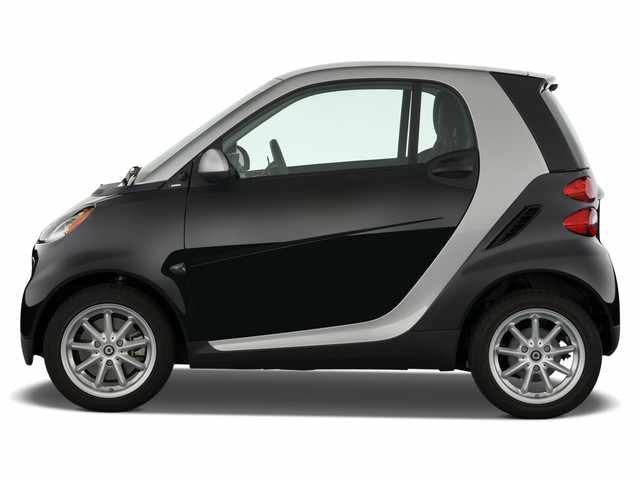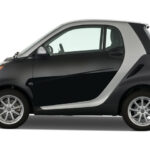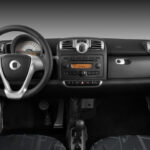
It wasn’t a good start. Maybe it was forshadowing for things to come. But whatever it was, getting into an argument with the manager at the Mercedes-Benz dealership before I picked up my tester was a first for me.
Now, I should say, it was a friendly argument. And admittedly, my stubborn nature prevented me from knowing when to let it go. But I just had to say something.
As the manager handed me the keys to the 2009 Smart Fortwo, he enclosed a package of information; specs and the like. I was all set to go, when suddenly he said, “Oh, and you can get it as a roadster too!”
I was literally walking away from him when he decided to yell this out to me, and I don’t think I’ve ever stopped so suddenly in my tracks before. I turned around, and looked at him. He had a very friendly smile on his face, so I thought he was joking. In fact, I knew he was joking. I knew there was no way he was referring the the Smart Fortwo Cabriolet as a ‘roadster’.
So, I managed a decent fake laugh and continued on. Then I heard, “What’s so funny?”
He was serious. I couldn’t believe it. And this is where the argument started.
He said that since the Smart is a two seater, and is available as a cabriolet, then it is a roadster. Taken literally, this definition could be true.
But when you hear roadster, what comes to mind? The Boxter? The 370Z? The SLK?
These are all performance cars, or at least more so than the Smart. And this was my problem. Despite the fact that the brochure itself labeled it as a ‘cabriolet’, the Smart in no way markets itself as a performance car, and thus, should not have a performance designation attached to it.
After about 10 minutes of debating, I finally managed to let it go since my tester was the ‘coupe’ anyway.
Immediately, I could tell that this generation Smart is miles ahead of the previous generation in the exterior design department. Having a previous gen Smart parked right next to it, probably helped me reach my conclusion so quickly.
The front end is much cleaner, and dare I say, more aggressive. Nicer headlights, and a front facia that gives the appearance of a wider stance helped. The side profile is sleeker (I use that term loosely) and less bubble-like, and the rear is nicely laid out as well. So far so good, aside from the dorky looking hubcaps. The Smart looks much better with alloys.
The interior is leaps and bounds ahead of the previous gen interior. But that’s kind of like saying Fast and Furious is better than Tokyo Drift. It’s still pretty bad.
Interior room is more than expected, but again, you could use the Fast & Furious analogy here too. Don’t expect to carry much stuff. The cupholders are oddly placed on the floor, so you need to bend down to pick up your coffee which, as I found more than once, can encourage unintentional weaving of the car, all while trying not to spill your beverage everywhere.
The seats are fine for about ten minutes. Then you start to wonder why your back is aching. They’re about as comfortable as Larry David at the Opera.
Unfortunately, I did not realize this before I set off for a two hour trip to Aylesford, Nova Scotia (it’s not worth your time looking it up to see what the great attractions might be because you’ll quickly find that a used clothing store is the best Aylesford has to offer).
But first, let’s talk about the biggest news for the 2009 Smart. The CDI disel engine has been replaced with a regular Joe gas engine with three cylinders making 70 horsepower. Given the Smart’s size and weight, this is adequate for power. Like the diesel, the engine is placed in the back, inside the cabin under a flimsy looking/feeling cardboard cover. This means there is quite a lot of engine noise when the Smart is pushed. Still, it’s quieter than the traditionally forte-sounding diesel.
On the brochure I was given, it mentions a newly developed 5 speed automatic that “now provides for even faster gear shifting, virtually free of any delays”. I’ve heard smaller fibs from the Bush administration.
A turtle could shift faster than this transmission does. A snail could. Your grandmother could. You get the idea. Shifting in manual mode does not help either.
Since gear shifts are so painfully slow, the Smart takes one hell of a nose dive from shift to shift. It feels like you’re driving a rocking chair as a result. Those who suffer easily from sea sickness should probably keep away.
In first gear though, the little Smart scoots off quite quickly. This is great for merging onto the highway. But that’s the only thing the Smart has going for it on the highway. On the way to Aylesford, my arm muscles got a good work out while trying to keep the Smart centered in its lane due to the wind pushing it back and fourth. This was with 30 k/h winds. I never wished I had Phat Albert next to me to weigh the Smart down more in my life.
Once I made it to Aylesford, I decided to replenish the energy I lost trying to keep the Smart from blowing off the highway, and parked at Subway. My arms didn’t get a break. In tight corners, say into a parking spot, the Smart’s steering suddenly becomes very stiff. I thought the power steering had gone, so I got out to see if there was any leaking fluid.
It was then, that I noticed the Smart had a headlight out, and didn’t even warn me. As if that wasn’t bad enough, there was no evidience of power steering failure. So that is just how the Smart drives, I suppose.
When I got back, I took it to the dealership to get the headlight fixed and to ask about the steering. The service guy said that the power steering was fine, but it did feel kind of ‘funny’. Then he asked how much I liked the fuel efficiency of it.
Um, that is what the Smart is all about. I only went through a quarter of a tank of gas for my trip. The Smart is rated at 5.9 city and 4.8 highway. Very impressive. Or is it?
A Toyota Yaris gets 6.9 city and 5.5 highway. It has two more doors, three more seats and has more cargo and versatility. To me, the extra 1 litre burned in the city would be worth it for all the other extras you get.
And here’s the other thing. The Smart starts at $15,000, while the Yaris starts at $13,000. A Honda Fit, which easily is the best in its class starts at around $14,000 with similar efficiency ratings and way more space than the Smart or the Yaris.
After the headlight was all fixed, I took the Smart out again. I still hated it, but there was something interesting that I somehow didn’t realize before. The Smart has a following.
Other Smart owners would honk and wave at me. Aside from two 10 year old boys who pointed and laughed, most people who didn’t even own Smart cars smiled and waved as I drove by. A lot of curious onlookers came up to ask more about it.
Suddenly, I wasn’t so ashamed of the Smart. Suddenly, it seemed cool.
That’s what the Smart is really all about. It’s about being trendy or making a statement. I parked, and got out to take a look at it again.
It’s such a quirky, unique car that it’s hard to hate it despite its numerous faults. And I have a soft spot for quirky cars.
Then I noticed the other headlight was burned out. Son of a….
Price as tested: $16,495
Summary: As trendy as Chai lattes, but just as annoying as the people who buy them.
Exterior design: 8/10. With alloys, the Smart can actually look like a mean little bug.
Interior design: 6/10. As quirky as a Saab interior, except way cheaper looking.
Engine: 7/10. Quieter than the diesel, but don’t get rid of your earplugs.
Transmission: 3/10. You can do your taxes in the time it takes to shift from gear to gear.
Audio/visual: 6/10. About what you’d expect from a car in this price range.
Value: 5/10. You can get 5-door hatches with comparable fuel efficiency numbers for less.
Overall: 5.5/10









